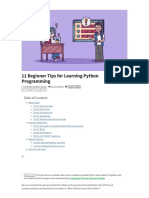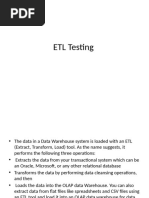Java Regular Expressions Cheat Sheet
Uploaded by
SpamMe SharpJava Regular Expressions Cheat Sheet
Uploaded by
SpamMe SharpFor m ore
awesom
Regex cheat sheet vis it rebe e cheat s heets
ll abs.org!
Character classes Useful Java classes & methods Quantifiers
[abc] matches a or b, or c. PATTERN
[^abc] negation, matches everything except a, b, or c. A pattern is a compiler representation of a regular expression. Greedy Reluctant Possessive Description
[a-c] range, matches a or b, or c.
Pattern compile(String regex)
[a-c[f-h]] union, matches a, b, c, f, g, h. X? X?? X?+ X, once or not at all.
Compiles the given regular expression into a pattern.
[a-c&&[b-c]] intersection, matches b or c.
[a-c&&[^b-c]] subtraction, matches a. X* X*? X*+ X, zero or more times.
Pattern compile(String regex, int flags)
Compiles the given regular expression into a pattern
X+ X+? X++ X, one or more times.
Predefined character classes with the given flags.
. Any character. boolean matches(String regex) X{n} X{n}? X{n}+ X, exactly n times.
\d A digit: [0-9] Tells whether or not this string matches the given
\D A non-digit: [^0-9] regular expression.
\s A whitespace character: [ \t\n\x0B\f\r] X{n,} X{n,}? X{n,}+ X, at least n times.
\S A non-whitespace character: [^\s] String[] split(CharSequence input)
\w A word character: [a-zA-Z_0-9] Splits the given input sequence around matches of X, at least n but
X{n,m} X{n,m}? X{n,m}+
\W A non-word character: [^\w] this pattern. not more than m times.
String quote(String s) Greedy - matches the longest matching group.
Boundary matches Returns a literal pattern String for the specified String. Reluctant - matches the shortest group.
^ The beginning of a line. Possessive - longest match or bust (no backoff).
$ The end of a line. Predicate<String> asPredicate()
\b A word boundary. Creates a predicate which can be used to match a string.
\B A non-word boundary. Groups & backreferences
\A The beginning of the input. MATCHER
\G The end of the previous match. An engine that performs match operations on a character A group is a captured subsequence of characters which may
\Z The end of the input but for the final terminator, if any. sequence by interpreting a Pattern. be used later in the expression with a backreference.
\z The end of the input. boolean matches()
(...) - defines a group.
Attempts to match the entire region against the pattern.
\N - refers to a matched group.
Pattern flags boolean find()
(\d\d) - a group of two digits.
Pattern.CASE_INSENSITIVE - enables case-insensitive Attempts to find the next subsequence of the input
(\d\d)/\1- two digits repeated twice.
matching. sequence that matches the pattern.
\1 - refers to the matched group.
Pattern.COMMENTS - whitespace and comments starting
with # are ignored until the end of a line. int start()
Pattern.MULTILINE - one expression can match
multiple lines.
Returns the start index of the previous match.
Logical operations
Pattern.UNIX_LINES - only the '\n' line terminator int end() XY X then Y.
is recognized in the behavior of ., ^, and $. Returns the offset after the last character matched. X|Y X or Y.
You might also like
- Strapack I-10 Instruction-Parts Manual MBNo ratings yetStrapack I-10 Instruction-Parts Manual MB26 pages
- Data Career Guide Udacity 2017 06 13 PDFNo ratings yetData Career Guide Udacity 2017 06 13 PDF47 pages
- Unit 1 Introduction To BIG DATA ANALYSIS: Evolution of TechnologyNo ratings yetUnit 1 Introduction To BIG DATA ANALYSIS: Evolution of Technology9 pages
- Case Study Based On: Cloud Deployment and Service Delivery ModelsNo ratings yetCase Study Based On: Cloud Deployment and Service Delivery Models10 pages
- MongoDB's Performance Over RDBMS - MongoDBNo ratings yetMongoDB's Performance Over RDBMS - MongoDB12 pages
- HTML Enhanced For Web Apps! Sagar AcharyaNo ratings yetHTML Enhanced For Web Apps! Sagar Acharya26 pages
- Difference Between Data Science and Machine LearningNo ratings yetDifference Between Data Science and Machine Learning5 pages
- Digital Vidya Python Data Analytst CourseNo ratings yetDigital Vidya Python Data Analytst Course18 pages
- Top 100 Deep Learning Interview QuestionsNo ratings yetTop 100 Deep Learning Interview Questions157 pages
- 11 Beginner Tips For Learning Python Programming - Real PythonNo ratings yet11 Beginner Tips For Learning Python Programming - Real Python8 pages
- Lambda Expressions With Collections UdemyNo ratings yetLambda Expressions With Collections Udemy9 pages
- A Review On Computational Methods For Denoising and Detecting ECG Signals To Detect Cardiovascular DiseasesNo ratings yetA Review On Computational Methods For Denoising and Detecting ECG Signals To Detect Cardiovascular Diseases40 pages
- Future Skills - An Introduction, General Overview of The Future Skills Sub-Sector-1No ratings yetFuture Skills - An Introduction, General Overview of The Future Skills Sub-Sector-115 pages
- Hadoop Fundamentals and Hive Interview QuestionsNo ratings yetHadoop Fundamentals and Hive Interview Questions8 pages
- (Skiena, 2017) - Book - The Data Science Design Manual - 3No ratings yet(Skiena, 2017) - Book - The Data Science Design Manual - 31 page
- Astronomy - Galaxies and The Expanding UniverseNo ratings yetAstronomy - Galaxies and The Expanding Universe226 pages
- Serverless Architecture For Product Defect Detection Using Computer Vision RaNo ratings yetServerless Architecture For Product Defect Detection Using Computer Vision Ra1 page
- طالب الدليمي اقتصاد السوق بحث في أصوله وأسباب تجدد الدعوة أليه PDFNo ratings yetطالب الدليمي اقتصاد السوق بحث في أصوله وأسباب تجدد الدعوة أليه PDF23 pages
- IT Helpdesk Support Analyst in Houston TX Resume Marcus FloresNo ratings yetIT Helpdesk Support Analyst in Houston TX Resume Marcus Flores3 pages
- UG B.A. History (English) UG B.A. English 108 53 History V Semester International Relations From 1914 AD Till Present 7030 1848No ratings yetUG B.A. History (English) UG B.A. English 108 53 History V Semester International Relations From 1914 AD Till Present 7030 1848236 pages
- Was That Supposed To Be Funny - A Rhetorical Analysis of Politics PDFNo ratings yetWas That Supposed To Be Funny - A Rhetorical Analysis of Politics PDF181 pages
- Wearable Microstrip Patch Antennas With Different Flexible SubstratesNo ratings yetWearable Microstrip Patch Antennas With Different Flexible Substrates6 pages
- S8800C Nitrous Oxide Sedation System - BrochureNo ratings yetS8800C Nitrous Oxide Sedation System - Brochure2 pages
- GAIL (India) Limited: Advt. No. GAIL/Pata/MS/Contract/01/15 Engagement of Medical Professionals On Contract BasisNo ratings yetGAIL (India) Limited: Advt. No. GAIL/Pata/MS/Contract/01/15 Engagement of Medical Professionals On Contract Basis2 pages
- Bachelor of Science in Computer Engineering (Effective SY: 2014 - 2015)No ratings yetBachelor of Science in Computer Engineering (Effective SY: 2014 - 2015)6 pages
- Women in Antiquity New Assessments 1st Edition Richard Hawley pdf download100% (2)Women in Antiquity New Assessments 1st Edition Richard Hawley pdf download47 pages
- Diana Hernandez Cruz - North-South Dispute Over Slavery Led To Civil War - Student PacketNo ratings yetDiana Hernandez Cruz - North-South Dispute Over Slavery Led To Civil War - Student Packet4 pages
- (Petition) Filed Under Rule 45 of The Rules of CourtNo ratings yet(Petition) Filed Under Rule 45 of The Rules of Court11 pages

























































































